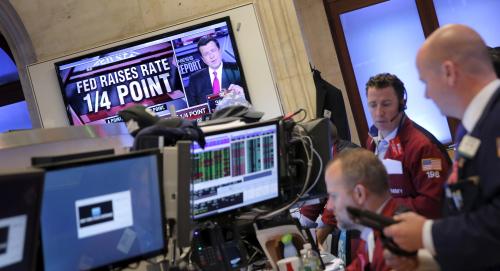This paper was presented at the 2018 Municipal Finance Conference on July 16 & 17,2018. The conference is a collaboration of the Brookings Institution’s Hutchins Center on Fiscal and Monetary Policy, the Brandeis International Business School’s Rosenberg Institute of Public Finance, Washington University in St. Louis’s Olin Business School, and the University of Chicago’s Harris Institute of Public Policy. It aims to bring together academics, practitioners, issuers, and regulators to discuss recent research on municipal capital markets and state and local fiscal issues.
For years, Puerto Rico’s economic and fiscal picture was deteriorating. Between 2005 and 2013, real GDP declined by 15 percent, while between 2000 and 2015 Puerto Rico’s government liabilities to GDP grew from 70 percent to 109 percent. Nevertheless, investors continued to purchase millions of dollars of Puerto Rico’s bonds with only a modest risk premium. In a paper to be presented at the 2018 Municipal Finance Conference, “What Went Wrong? The Puerto Rican Debt Crisis and the ‘Treasury Put,’” three economists from the University of Illinois at Chicago ask why investors were so willing to continue to lend to Puerto Rico. Their answer: investors assumed the federal government would ultimately bail out Puerto Rico.
[T]he Treasury Put is an “implicit guarantee by the federal government to provide support in the event of financial distress by the issuer of Puerto Rican bonds as perceived by investors.”
“The expectation of a federal bailout was perfectly reasonable given past behavior by the federal government, especially the prior bailout of New York,” authors Robert Chirinko, Ryan Chiu, and Shaina Henderson say. However, when the government refused to bail out the city of Detroit in 2013, investors realized their assumptions about a federal bailout for Puerto Rico were wrong. This provided a natural experiment to measure the value of what they call the “Treasury Put.” Per the authors, the Treasury Put is an “implicit guarantee by the federal government to provide support in the event of financial distress by the issuer of Puerto Rican bonds as perceived by investors.” The authors say their work challenges the view of some analysts, including the Government Accountability Office, that the Puerto Rico debt crisis was the result of inadequate disclosure by Puerto Rico of its financial condition. The authors begin by comparing the yields on privately insured and uninsured Puerto Rican general obligation bonds issued on the same days between the years 2000 and 2013, relative to the yields on Aaa, Baa, and junk-rated corporate bonds. Using that data, they estimate the risk premium that investors demand for buying uninsured Puerto Rican debt, and find it to be “exceptionally low,” given Puerto Rico’s fundamentals. This, they say, “was eminently reasonably given the expectation of financial support from the U.S. Treasury.”
That expectation was shattered in July 2013 when the federal government refused to bail out Detroit, which had filed for bankruptcy. Although no new bonds were issued by Puerto Rico after this so-called “seismic event,” the authors estimate the risk premium on the bonds by tracking the divergence in market prices on the uninsured and insured bonds – and find it rose substantially. For instance, in May 2013, two months before the Detroit bankruptcy, the authors estimate the average risk premium on Puerto Rican bonds at 2.56 percentage points. Two months after Detroit’s filing, the average risk premium was at 4.23 percentage points. In short, the authors estimate that investors’ pre-Detroit expectations that the federal government would bail out Puerto Rico reduced the interest rate that Puerto Rico paid to borrow by 3.5 percentage points. The paper concludes that financial markets failed to limit the flow of capital to Puerto Rico, resulting in a misallocation of capital, because of the Treasury Put, and argue that the government should seek ways to eliminate this sort of implicit guarantee while providing a safety net to protect citizens from harm. This, they acknowledge, may reflect the “Gordian Knot connecting unfettered markets, restrictive policies, and political interests,” making it challenging for any democracy to resolve.





Commentary
Why didn’t investors demand higher yields for buying Puerto Rican government bonds?
July 16, 2018